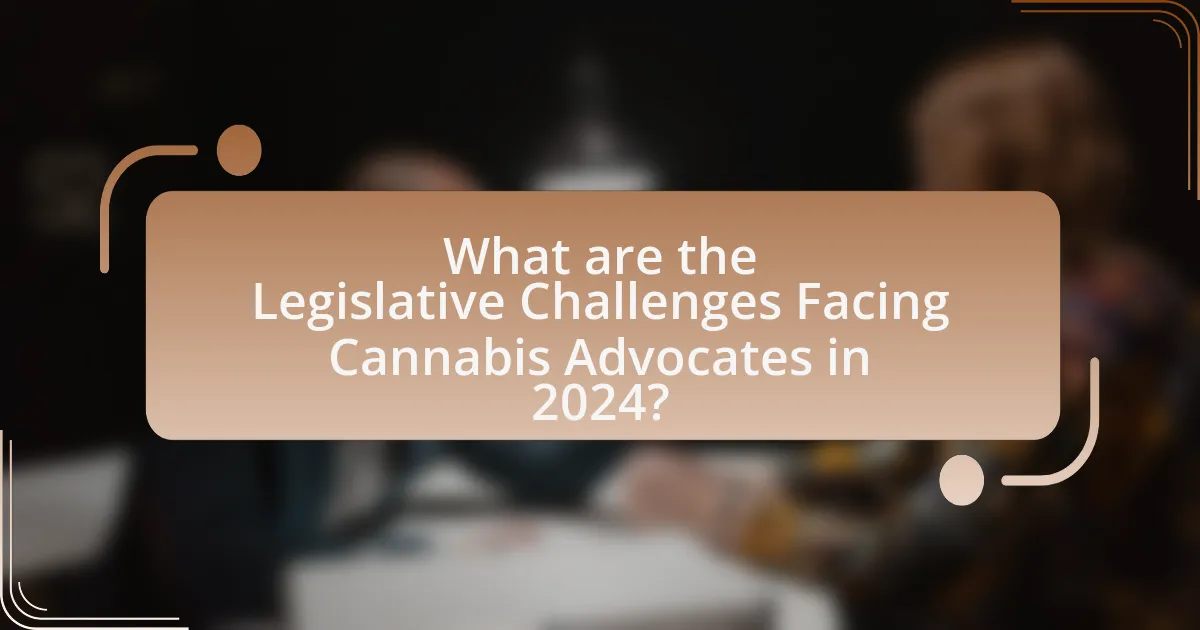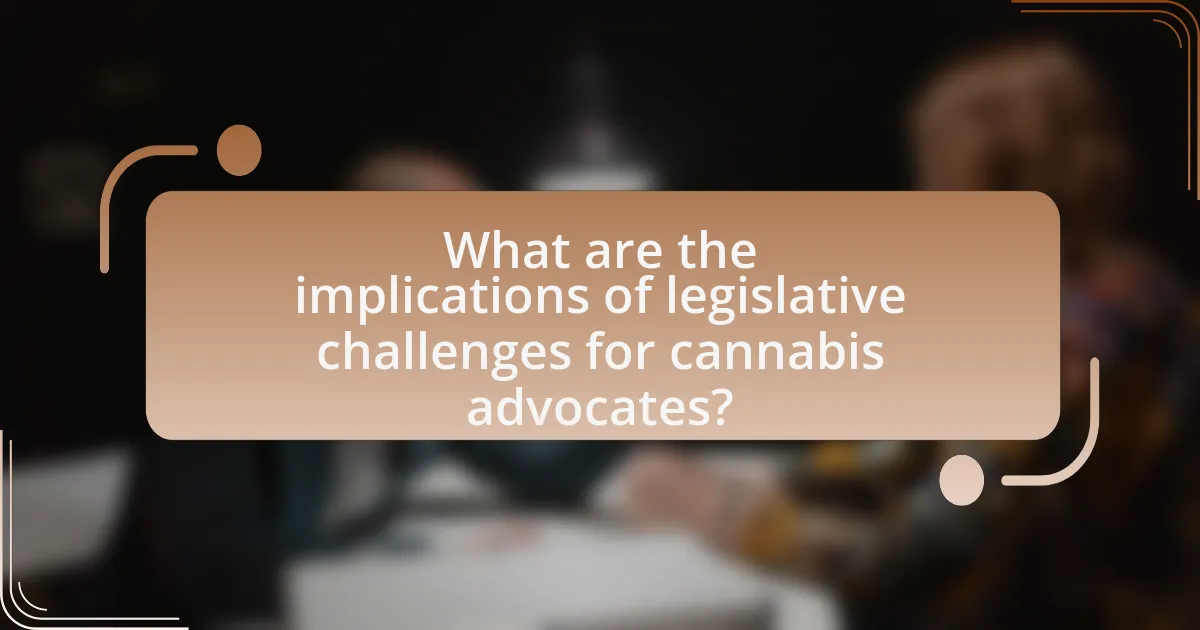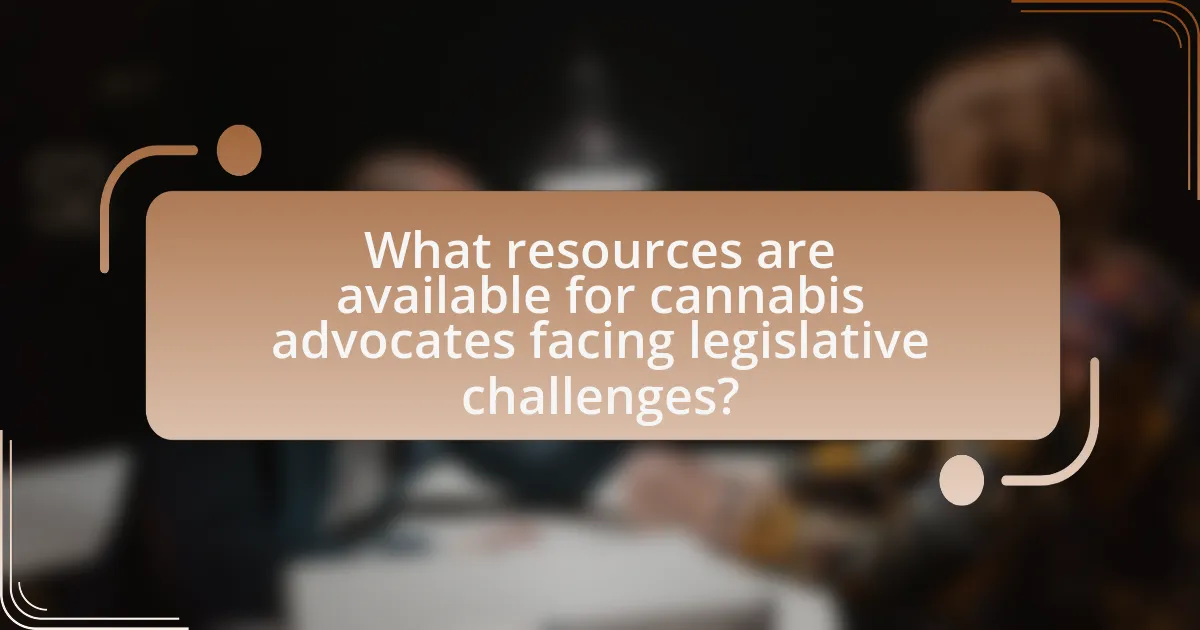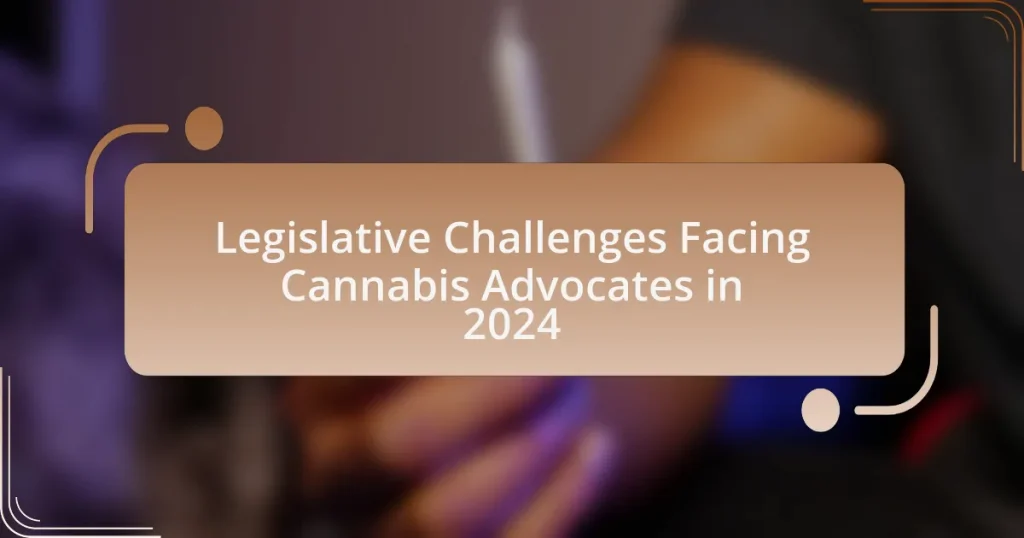The article examines the legislative challenges facing cannabis advocates in 2024, highlighting the complexities arising from ongoing federal prohibition and inconsistent state laws. It discusses how current laws impact advocacy efforts, the specific regulations that hinder progress, and the challenges posed by the conflict between state and federal legislation. Additionally, the article emphasizes the importance of public perception in shaping cannabis laws, the influence of political factors and lobbyists, and the strategies advocates are employing to overcome these obstacles. It also outlines the resources available for advocates and best practices for effective advocacy in the evolving legal landscape.

What are the Legislative Challenges Facing Cannabis Advocates in 2024?
Cannabis advocates in 2024 face significant legislative challenges, primarily due to ongoing federal prohibition and inconsistent state laws. The federal government has not yet legalized cannabis, creating a complex legal landscape that complicates advocacy efforts. Additionally, states with varying regulations can lead to confusion and hinder the establishment of a cohesive national policy. For instance, while some states have legalized recreational use, others maintain strict prohibitions, resulting in disparities that advocates must navigate. Furthermore, the lack of federal banking access for cannabis businesses poses financial hurdles, limiting their ability to operate effectively. These challenges underscore the need for comprehensive reform to unify cannabis legislation across the United States.
How do current laws impact cannabis advocacy efforts?
Current laws significantly shape cannabis advocacy efforts by determining the legal framework within which advocates operate. For instance, in jurisdictions where cannabis remains illegal, advocacy is often met with legal repercussions, limiting the ability to organize and campaign effectively. Conversely, in areas where cannabis is legalized, advocates can mobilize more freely, pushing for further reforms and addressing issues such as social equity and public health. According to a 2022 report from the National Organization for the Reform of Marijuana Laws, states with more progressive cannabis laws have seen increased advocacy success, highlighting the correlation between legal status and the effectiveness of advocacy initiatives.
What specific regulations are hindering cannabis advocates?
Specific regulations hindering cannabis advocates include federal prohibition under the Controlled Substances Act, which classifies cannabis as a Schedule I substance, thereby limiting research and access to banking services. Additionally, state-level regulations vary widely, with some states imposing strict licensing requirements and high taxes that create barriers for small businesses. For instance, in California, the cannabis tax rate can exceed 30%, making it difficult for advocates to promote equitable access and affordability. These regulatory challenges restrict the growth of the cannabis industry and limit advocacy efforts aimed at reforming laws.
How do state versus federal laws create challenges for advocates?
State versus federal laws create challenges for advocates by creating a conflicting legal landscape that complicates efforts to promote cannabis legalization and reform. For instance, while many states have legalized cannabis for medical or recreational use, it remains classified as a Schedule I substance under the federal Controlled Substances Act, which prohibits its use and distribution. This discrepancy leads to legal risks for advocates, including potential federal prosecution, loss of funding, and difficulties in accessing banking services. Additionally, advocates face challenges in mobilizing public support and influencing policy when federal laws undermine state-level progress, creating confusion among the public and lawmakers about the legality and safety of cannabis use.
Why is public perception important for cannabis legislation?
Public perception is crucial for cannabis legislation because it directly influences policymakers and their willingness to enact or amend laws. When a significant portion of the public supports cannabis legalization, legislators are more likely to respond to this demand, as seen in states like Colorado and California, where public support led to successful legalization efforts. Additionally, research from the Pew Research Center indicates that as of 2021, 60% of Americans favor legalizing cannabis, demonstrating a shift in societal attitudes that can drive legislative change. Thus, positive public perception can create a conducive environment for cannabis advocates to overcome legislative challenges.
What role does public opinion play in shaping cannabis laws?
Public opinion significantly influences the development and modification of cannabis laws. When a majority of the population supports cannabis legalization or reform, lawmakers are more likely to respond by enacting or adjusting legislation to reflect these views. For instance, a 2021 Gallup poll indicated that 68% of Americans favored legalizing cannabis, which has led to numerous states revising their laws to permit recreational or medical use. This correlation between public sentiment and legislative action demonstrates that as societal attitudes shift, so too do the legal frameworks governing cannabis.
How can advocates influence public perception of cannabis?
Advocates can influence public perception of cannabis by utilizing education, media engagement, and community outreach. Education initiatives, such as providing accurate information about the benefits and risks of cannabis, help dispel myths and reduce stigma. For instance, studies have shown that informed individuals are more likely to support legalization efforts; a 2021 survey indicated that 68% of Americans favor legalizing cannabis when they understand its medical benefits. Media engagement, including social media campaigns and public speaking, allows advocates to reach broader audiences and shape narratives around cannabis use. Community outreach, through events and partnerships with local organizations, fosters dialogue and personal connections, further shifting perceptions. These strategies collectively contribute to a more informed and supportive public stance on cannabis.
What are the key political factors affecting cannabis legislation in 2024?
The key political factors affecting cannabis legislation in 2024 include shifting public opinion, state-level initiatives, and federal regulatory changes. Public support for cannabis legalization has reached approximately 68% in the U.S., influencing lawmakers to consider reform. Additionally, several states are proposing ballot measures for legalization, reflecting local political climates and advocacy efforts. Federal regulatory changes, particularly the potential for Congress to pass comprehensive cannabis reform, are also pivotal, as they could standardize regulations and impact state laws. These factors collectively shape the legislative landscape for cannabis in 2024.
How do political party positions impact cannabis advocacy?
Political party positions significantly impact cannabis advocacy by shaping legislative priorities and influencing public perception. For instance, parties that support cannabis legalization often promote policies that facilitate reform, leading to increased funding for advocacy groups and legislative initiatives. In contrast, parties opposed to legalization may enact restrictive laws, limiting access to cannabis and hindering advocacy efforts. Historical data shows that states with Democratic leadership have generally moved towards legalization, while Republican-led states have maintained stricter regulations. This dynamic illustrates how party ideologies directly affect the progress and challenges faced by cannabis advocates in the legislative arena.
What influence do lobbyists have on cannabis legislation?
Lobbyists significantly influence cannabis legislation by advocating for specific policies and regulations that align with their clients’ interests. They engage with lawmakers, providing research, data, and arguments that support the legalization or regulation of cannabis, often emphasizing economic benefits such as tax revenue and job creation. For instance, the National Cannabis Industry Association has been instrumental in lobbying for favorable legislation, highlighting that legal cannabis markets can generate billions in tax revenue, as seen in states like Colorado, which reported over $1.7 billion in cannabis sales in 2020. This financial incentive can sway legislative decisions, making lobbyists a powerful force in shaping cannabis policy.
How are cannabis advocates responding to legislative challenges?
Cannabis advocates are responding to legislative challenges by mobilizing grassroots campaigns and lobbying efforts to influence policymakers. These advocates are organizing public demonstrations, utilizing social media to raise awareness, and forming coalitions with other advocacy groups to strengthen their impact. For instance, in states facing restrictive cannabis laws, advocates have successfully gathered signatures for ballot initiatives, demonstrating public support for legalization or reform. Additionally, they are providing educational resources to legislators and the public about the benefits of cannabis legalization, which has been shown to generate significant tax revenue and reduce criminal justice costs.
What strategies are being employed to overcome these challenges?
Cannabis advocates are employing grassroots mobilization and coalition-building strategies to overcome legislative challenges in 2024. Grassroots mobilization involves engaging local communities to raise awareness and support for cannabis reform, which has proven effective in influencing public opinion and legislative outcomes. Coalition-building brings together diverse stakeholders, including medical professionals, business owners, and social justice organizations, to create a unified front that amplifies their collective voice. For instance, the National Organization for the Reform of Marijuana Laws (NORML) has successfully partnered with various advocacy groups to push for legislative changes, demonstrating the power of collaboration in overcoming obstacles.
How can grassroots movements support cannabis advocacy?
Grassroots movements can support cannabis advocacy by mobilizing community members to raise awareness and influence policy changes. These movements often engage in local campaigns, organize events, and utilize social media to educate the public about the benefits of cannabis legalization and reform. For instance, the National Organization for the Reform of Marijuana Laws (NORML) has effectively used grassroots efforts to advocate for legislative changes, resulting in the legalization of cannabis in several states. Additionally, grassroots movements can provide a platform for individuals to share personal stories, which humanizes the issue and can sway public opinion and lawmakers.
What role does coalition-building play in legislative efforts?
Coalition-building plays a crucial role in legislative efforts by uniting diverse stakeholders to advocate for common goals, thereby increasing the likelihood of passing legislation. In the context of cannabis advocacy, forming coalitions among various groups—such as health organizations, civil rights advocates, and economic stakeholders—amplifies their collective voice and influence. For instance, the National Organization for the Reform of Marijuana Laws (NORML) has successfully collaborated with other advocacy groups to push for legalization measures in multiple states, demonstrating that a united front can effectively sway public opinion and legislative outcomes. This strategic alliance not only consolidates resources but also enhances credibility, making it easier to navigate the complexities of the legislative process.

What are the implications of legislative challenges for cannabis advocates?
Legislative challenges significantly hinder cannabis advocates by creating barriers to legalization and reform efforts. These challenges often result in prolonged legal battles, increased regulatory scrutiny, and the potential for inconsistent state laws, which can undermine advocacy efforts. For instance, in 2023, states like Texas and Idaho faced legislative setbacks that delayed proposed cannabis reforms, illustrating how political opposition can stall progress. Additionally, these challenges can lead to increased stigma and public misunderstanding about cannabis, further complicating advocacy initiatives aimed at education and acceptance.
How do legislative challenges affect the cannabis industry?
Legislative challenges significantly hinder the cannabis industry by creating uncertainty and limiting market access. For instance, varying state laws regarding cannabis legality can lead to complications for businesses operating across state lines, resulting in inconsistent regulations and compliance costs. According to a 2021 report by the Congressional Research Service, the lack of federal legalization restricts banking access for cannabis companies, forcing them to operate primarily in cash, which increases security risks and operational inefficiencies. Additionally, legislative hurdles can delay the establishment of regulatory frameworks, stifling innovation and investment in the sector.
What economic impacts arise from restrictive cannabis laws?
Restrictive cannabis laws lead to significant economic impacts, including lost tax revenue, increased law enforcement costs, and stunted job creation in the cannabis industry. For instance, states that have legalized cannabis have generated billions in tax revenue; Colorado alone collected over $1.7 billion in cannabis taxes from 2014 to 2021. Conversely, restrictive laws prevent these potential revenues and maintain high costs associated with policing and prosecuting cannabis-related offenses, which can exceed millions annually. Additionally, restrictive regulations limit the growth of a legal cannabis market, resulting in fewer job opportunities; the legal cannabis industry is projected to create over 1 million jobs by 2025 in states where it is legalized, a figure that remains unrealized in states with strict laws.
How do legal challenges influence market growth for cannabis?
Legal challenges significantly hinder market growth for cannabis by creating uncertainty and limiting access to legal markets. When jurisdictions impose strict regulations or face ongoing litigation regarding cannabis legality, potential investors and businesses may hesitate to enter the market due to perceived risks. For instance, in states where legal battles over cannabis regulations are prevalent, market expansion can stall, as seen in California, where regulatory complexities have slowed the growth of the legal cannabis industry. Furthermore, legal challenges can lead to inconsistent enforcement of laws, which discourages consumer confidence and participation in the market. This dynamic ultimately restricts the overall economic potential of the cannabis sector, as evidenced by reports indicating that states with more stable legal frameworks experience faster market growth compared to those embroiled in legal disputes.
What are the potential future trends in cannabis legislation?
Potential future trends in cannabis legislation include increased federal legalization efforts in the United States, as evidenced by the growing support for the Cannabis Administration and Opportunity Act, which aims to decriminalize cannabis at the federal level. Additionally, states are likely to continue expanding their medical and recreational cannabis programs, with more jurisdictions considering legalization measures in response to public opinion and tax revenue potential. Furthermore, there may be a trend towards more comprehensive regulations addressing social equity, allowing for the inclusion of communities disproportionately affected by past cannabis prohibition. This shift is supported by various studies indicating that equitable access to the cannabis industry can help rectify historical injustices.
How might upcoming elections influence cannabis advocacy?
Upcoming elections may significantly influence cannabis advocacy by determining the legislative priorities and composition of governing bodies. As candidates campaign, their positions on cannabis legalization and reform can mobilize voters and shape public discourse, potentially leading to increased support for cannabis-related initiatives. For instance, in states where candidates openly advocate for cannabis reform, there has been a correlation with higher voter turnout and successful ballot measures, as seen in the 2020 elections when several states legalized recreational cannabis. This trend indicates that electoral outcomes can directly impact the momentum and resources available for cannabis advocacy efforts.
What changes in public policy could benefit cannabis advocates?
Changes in public policy that could benefit cannabis advocates include the legalization of cannabis at the federal level, which would remove the conflict between state and federal laws. This change would enable cannabis businesses to access banking services, which are currently limited due to federal prohibition, and would facilitate research into cannabis benefits and safety. Additionally, implementing regulations that allow for equitable access to the cannabis market for marginalized communities can help address historical injustices related to cannabis prohibition. Evidence from states that have legalized cannabis shows increased tax revenue and reduced law enforcement costs, supporting the argument for these policy changes.

What resources are available for cannabis advocates facing legislative challenges?
Cannabis advocates facing legislative challenges can access various resources, including advocacy organizations, legal assistance, and educational materials. Organizations such as the National Organization for the Reform of Marijuana Laws (NORML) and the Marijuana Policy Project (MPP) provide support through lobbying efforts, legal guidance, and grassroots mobilization. Additionally, legal aid services specializing in cannabis law can offer assistance in navigating complex regulations. Educational resources, including webinars and publications, help advocates stay informed about current legislation and effective advocacy strategies. These resources collectively empower advocates to effectively address and overcome legislative hurdles.
How can advocates access legal support and guidance?
Advocates can access legal support and guidance through various resources, including legal aid organizations, bar associations, and specialized law firms that focus on cannabis law. Legal aid organizations often provide free or low-cost legal assistance to individuals and groups advocating for cannabis-related issues. Bar associations may offer referral services to connect advocates with attorneys experienced in cannabis legislation. Additionally, specialized law firms can provide tailored legal advice and representation, ensuring that advocates navigate the complex regulatory landscape effectively. These resources are crucial for addressing the unique legislative challenges faced by cannabis advocates in 2024.
What organizations provide resources for cannabis advocacy?
Organizations that provide resources for cannabis advocacy include the National Organization for the Reform of Marijuana Laws (NORML), the Marijuana Policy Project (MPP), and the Drug Policy Alliance (DPA). NORML focuses on reforming marijuana laws and provides educational resources and advocacy tools. The MPP works to change marijuana laws at the state and federal levels, offering research and legislative support. The DPA advocates for drug policy reform and provides resources for activists, including research and policy analysis. These organizations are instrumental in supporting cannabis advocacy efforts through their comprehensive resources and active engagement in legislative processes.
How can online platforms assist in advocacy efforts?
Online platforms can significantly assist in advocacy efforts by providing a space for information dissemination, community engagement, and mobilization. These platforms enable advocates to share educational content, updates on legislative changes, and calls to action, reaching a broader audience quickly. For instance, social media channels like Twitter and Facebook allow for real-time communication and the ability to rally support for specific initiatives, evidenced by campaigns that have successfully influenced public opinion and legislative outcomes. Additionally, online petitions and crowdfunding platforms facilitate grassroots fundraising and support, which are crucial for sustaining advocacy efforts. According to a 2021 study by the Pew Research Center, 69% of adults in the U.S. use social media, highlighting its potential as a powerful tool for advocacy in the cannabis sector, especially as advocates navigate the complex legislative landscape in 2024.
What best practices can cannabis advocates adopt in 2024?
Cannabis advocates can adopt best practices in 2024 by focusing on coalition-building, data-driven advocacy, and public education. Coalition-building allows advocates to unite various stakeholders, enhancing their influence and resources; for instance, partnerships with health organizations can strengthen arguments for legalization based on public health benefits. Data-driven advocacy involves utilizing research and statistics to support claims, such as referencing studies that demonstrate the economic benefits of legalized cannabis, which can sway policymakers. Public education campaigns are crucial for dispelling myths and informing the public about the benefits and safety of cannabis use, as evidenced by successful initiatives in states like Colorado, where informed public opinion has led to favorable legislation.
How can effective communication strategies enhance advocacy efforts?
Effective communication strategies can significantly enhance advocacy efforts by ensuring clear messaging, fostering engagement, and mobilizing support. Clear messaging helps convey the core issues and objectives of advocacy campaigns, making it easier for stakeholders to understand and rally behind the cause. For instance, studies show that campaigns with concise and targeted messages are 60% more likely to resonate with the public, leading to increased awareness and support. Additionally, effective communication fosters engagement through social media and community outreach, allowing advocates to connect with diverse audiences and build coalitions. This engagement is crucial in legislative contexts, where public opinion can influence policymakers. Furthermore, mobilizing support through well-crafted communication can lead to higher participation rates in advocacy activities, such as rallies or petitions, which are essential for demonstrating public backing to legislators.
What are the key elements of a successful advocacy campaign?
The key elements of a successful advocacy campaign include a clear objective, a well-defined target audience, strategic messaging, coalition building, and effective use of media. A clear objective provides direction and focus, ensuring that all efforts align with the desired outcome. Identifying a well-defined target audience allows advocates to tailor their messages and strategies to resonate with specific groups, increasing engagement and support. Strategic messaging is crucial for communicating the campaign’s goals and values in a compelling manner, often supported by data or testimonials to enhance credibility. Coalition building fosters collaboration among diverse stakeholders, amplifying the campaign’s reach and influence. Finally, effective use of media, including social media and traditional outlets, is essential for raising awareness and mobilizing supporters, as evidenced by successful campaigns that leverage these platforms to drive public discourse and policy change.


